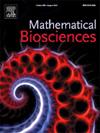3节点限制性兴奋-抑制网络的分类。
IF 1.8
4区 数学
Q2 BIOLOGY
引用次数: 0
摘要
我们对连接的3节点限制性兴奋-抑制网络进行了分类,扩展了我们之前的论文(Aguiar et al., 2024)。我们假设有两种节点类型和两种箭头类型,兴奋性和抑制性;所有兴奋性箭头是相同的所有抑制性箭头也是相同的;和兴奋(反应)。抑制性节点只能输出兴奋性节点。抑制)箭头。在两个网络视角下进行分类:ode等效性和极小性;价≤2。这一结果和之前的工作构成了分析兴奋-抑制网络的动力学和分支的第一步,并有潜在的应用于生物网络模型。本文章由计算机程序翻译,如有差异,请以英文原文为准。
Classification of 3-node restricted excitatory–inhibitory networks
We classify connected 3-node restricted excitatory–inhibitory networks, extending our previous paper (Aguiar et al., 2024). We assume that there are two node-types and two arrow-types, excitatory and inhibitory; all excitatory arrows are identical and all inhibitory arrows are identical; and excitatory (resp. inhibitory) nodes can only output excitatory (resp. inhibitory) arrows. The classification is performed under the following two network perspectives: ODE-equivalence and minimality; and valence . The results of this and the previous work constitute a first step towards analyzing dynamics and bifurcations of excitatory–inhibitory networks and have potential applications to biological network models.
求助全文
通过发布文献求助,成功后即可免费获取论文全文。
去求助
来源期刊

Mathematical Biosciences
生物-生物学
CiteScore
7.50
自引率
2.30%
发文量
67
审稿时长
18 days
期刊介绍:
Mathematical Biosciences publishes work providing new concepts or new understanding of biological systems using mathematical models, or methodological articles likely to find application to multiple biological systems. Papers are expected to present a major research finding of broad significance for the biological sciences, or mathematical biology. Mathematical Biosciences welcomes original research articles, letters, reviews and perspectives.
 求助内容:
求助内容: 应助结果提醒方式:
应助结果提醒方式:


